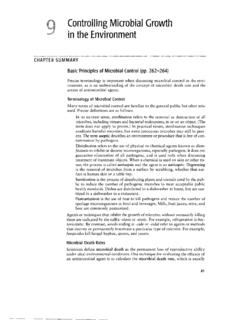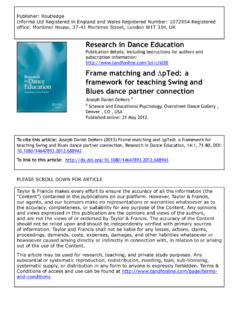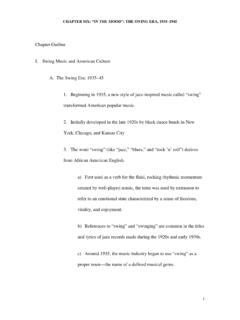Transcription of Ragtime, Blues, and Early Jazz VOCABULARY TERMS A …
1 Ragtime, Blues, & Early jazz VOCABULARY TERMS Page - 1 Ragtime, Blues, and Early jazz VOCABULARY TERMS jazz A musical style created mainly by African Americans in Early twentieth century that blended elements drawn from African music with the popular and art traditions of the West ragtime Late-nineteenth-century piano style created by African Americans, characterized by highly syncopated melodies; also played in ensemble arrangements. Contributed to Early jazz styles. strain A series of contrasting sections found in rags and marches; in duple meter with sixteen-measure themes or sections. blues African-American form of secular folk music, related to jazz , that is based on a simple, repetitive poetic-musical structure. blue note A slight drop of pitch on the third, fifth, or seventh tone of the scale, common in blues and jazz .
2 Also bent pitch. scat singing A jazz style that sets syllables without meaning (vocables) to an improvised vocal line. vocable Nonlexical syllables, lacking literal meaning. chorus Fairly large group of singers who perform together, usually with several on each part. Also a choral movement of a large-scale work. In jazz , a single statement of the melodic-harmonic pattern. improvisation Creation of a musical composition while it is being performed, seen in Baroque ornamentation, cadenzas of concertos, jazz , and some non-Western musics. syncopated Deliberate upsetting of the meter or pulse through a temporary shifting of the accent to a weak beat or an offbeat. art music A catch-all term for any music that was enjoyed by a smaller crowd; this included operas and classical type music.
3 Opera Music drama that is generally sung throughout, combining the resources of vocal and instrumental music with poetry and drama, acting and pantomime, scenery and costumes. symphony Large work for orchestra, generally in three or four movements. strophe Song structure in which the same music is repeated with every stanza (strophe) of the poem. spiritual Folk-like devotional genre of the United States, sung by African Americans and whites. Ragtime, Blues, & Early jazz VOCABULARY TERMS Page - 2 work song Communal song that synchronized group tasks. shouts An Early African-American ritual that involved singing, dancing , and shouting praises to God. polyphonic Two or more melodic lines combined into a multi-voiced texture. countermelody An accompanying melody sounded against the principal melody.
4 Fantasias Free instrumental piece of fairly large dimensions, in an improvisational style. call-and-response Performance style with a singing leader who is imitated by a chorus of followers. griot A West African storyteller and/or praise singer who led call-and-response type singing. Ragtime, Blues, & Early jazz RESEARCH ASSIGNMENT Compose a one-page report (handwritten) on five (5) out of the following (10) musicians: Scott Joplin Robert Johnson Charlie Patton Louis Armstrong Ella Fitzgerald Benny Goodman Count Basie Billie Holiday Artie Shaw BB King Ragtime, Blues, and Early jazz KEY POINTS All riddles are blues, And all blues are sad, And I m only mentioning Some blues I ve had. -MAYA ANGELOU o jazz arose in the Early twentieth century and drew elements from African traditions and from Western popular and art culture.
5 O Its roots are in West African music (including call-and-response singing) and in nineteenth-century African-American ceremonial and work songs. o Ragtime developed from an African-American piano style characterized by syncopated rhythms and sectional forms. o Scott Joplin, often considered the king of ragtime, is the first African-American composer to win international fame; he is remembered for his piano rags, especially Maple Leaf Rag. o Louis Armstrong is one of the great Early jazz performers (on trumpet); he also introduced scat singing (singing on syllables without meaning). o Armstrong was first associated with New Orleans-style jazz , which is characterized by a small ensemble of players improvising simultaneously. o Blues is an American genre of folk music based on a simple, repetitive, poetic-musical form with three-line strophes set to a repeating harmonic pattern of twelve bars.
6 O Billie Holiday is one of the leading female jazz singers, and was a composer as well. o Ragtime, blues, and jazz are rooted in the music of African-Americans. These musical styles are part of the great American identity, and have captured the imagination of the world. Ragtime, Blues, & Early jazz Unit Outline page 1 Ragtime, Blues, and Early jazz UNIT OUTLINE 1. jazz is a 20th-century American musical style Drew from African traditions and traditions from the West, began in New Orleans Roots of jazz are in West African music (call-and-response), and 19th-century African-American ceremonial and work songs Ragtime, a precursor to jazz , developed from African-American piano style characterized by syncopated rhythms and sectional forms 2. Scott Joplin (1868 1917) and Ragtime American Composer "The king of ragtime" Joplin and ragtime gained notice during a performance at the 1893 World Exposition (Chicago) Left St.
7 Louis for Chicago, then went to New York Active in New York as teacher, composer, performer Sought to elevate ragtime to a serious art form After poorly received opera premiere (Treemonisha), fell into period of depression Died in New York in 1917 Revival of Treemonisha in 1972 earned Joplin a posthumous Pulitzer Prize Some of his piano rags are preserved on recordings made by Joplin on Steinway player piano rolls 3. Joplin: Maple Leaf Rag (Listening Guide) Regular sectional form Four strains, each repeated Syncopated rhythms Ragtime, Blues, & Early jazz Unit Outline page 2 4. Blues and New Orleans jazz Blues: an American form of folk music based on a simple, repetitive, poetic-musical structure The term refers to a mood as well as harmonic progression Harmonic progression is usually 12 (or 16) bars in length Characteristic is the blue note (slight drop in pitch) Blues texts typically consist of a 3-line stanza, the first 2 lines are the same Vocal style derived from work songs The art of improvisation is critical in blues 5.
8 Louis Armstrong (1901 1971) and Early jazz American musician (cornet and trumpet) Nickname "Satchmo" Success in Chicago with the New Orleans style ensemble King Oliver Creole jazz Band Great improviser Used variety of mutes to expand capacities of trumpet in range and tone color Recording of Heebie Jeebies introduced scat singing (syllables without literal meaning) jazz chorus is a single statement of a melodic-harmonic pattern Armstrong introduced solo rather than ensemble choruses Style influenced generations of musicians Ragtime, Blues, & Early jazz Unit Outline page 3 6. The jazz Singer Billie Holiday (1915 1959) American blues and jazz singer Nickname "Lady Day" Tragic childhood Discovered by talent scout, sent to record with Benny Goodman Sang with the top jazz musicians of her day Life deteriorated into drug and alcohol abuse Died at 44 from cirrhosis of the liver Recognizable singing style 7.
9 Holiday: Billie's Blues (Listening Guide) Recorded with Artie Shaw on clarinet and Bunny Berigan on trumpet 12-bar blues Short introduction and six choruses Begins with 3-line strophe, but becomes freer Demonstrates her masterful rhythmic flexibility Cultural Perspective: The Roots of jazz Page 1 CULTURAL PERSEPECTIVE: The Roots of jazz jazz has been viewed by many as a truly American art form, but in reality it draws together traditions from West Africa, Europe, and the Americas. The African origins of jazz evoke an earlier episode of American history: the slave trade from Africa. Many of the slaves brought to America came from the west coast of Africa often called the Ivory or Gold Coast. It is not surprising, then, that studies comparing the musical traditions in sub-Saharan Africa with those in certain isolated regions of black America have confirmed many similarities.
10 These include singing styles (call-and-response patterns and various vocal inflections) and storytelling techniques, traits that have remained alive for several centuries in both regions through oral tradition. Black music in nineteenth-century America included dancing for ritual and ceremonial purposes and the singing of work songs (communal songs that synchronized the rhythm of group tasks) and spirituals (a kind of religious folk song, often with a refrain). West African religious traditions mingled freely with the Protestant Christianity adopted by some slaves. The art of storytelling through music, typical of many West African tribes, and praise singing (glorifying deities or royalty) were other traditions retained by slaves that would contribute to spirituals and blues.















